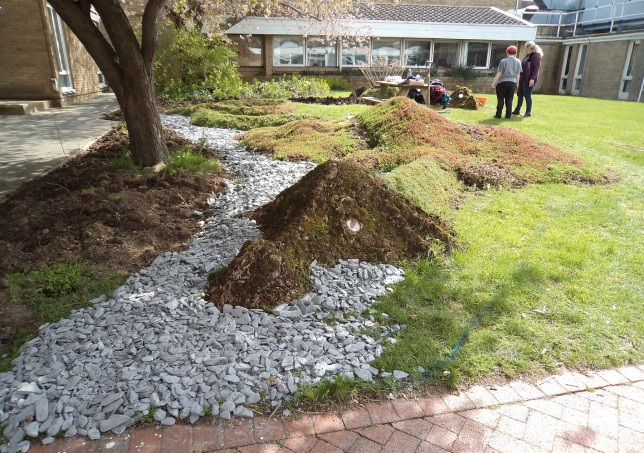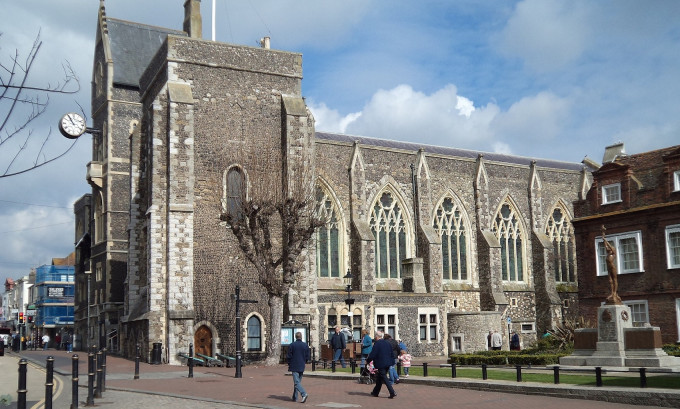First and foremost, the Medieval Canterbury Weekend 2024 is now up and you can see the programme with links to the booking pages at: https://ckhh.org.uk/mcw and you can also reach the MCW24 using canterbury.ac.uk/medieval-canterbury which links to the new one above. For those looking for the new CKHH website more generally, please use: https://ckhh.org.uk/ and you can also link to the blog that way too. Once the CCCU Bookshop has added MCW24 to their ‘Events’ page, I’ll give you that link too.
Even though this has been a teaching week before the end of term, it has also been a week of meetings and other activities. For instance, Dr Diane Heath was out at the Franciscan Gardens ‘Green Dragon’ site with Dr Pip Gregory on Wednesday afternoon as they did further preparatory work as the dragon begins to take shape. However, they were somewhat hampered by the weather, even in the South-East we seem to have had more than our fair share of rain. Although subsequent to NLHF ‘Medieval Animals Heritage’, this dragon comes within the scope of the project because it links to Sustainability and the Climate Emergency, making it important and topical. Moreover, Diane will be working with Martin Crowther this week to complete the project’s final report to the National Lottery.

Dr Claire Bartram has been working with Ben on the new website, co-ordinating the supplying of new materials and other details, so please do have a look. Claire is also working with Dr Astrid Stilma concerning the AHRC-funded Aphra Behn project and specifically the ‘Inspirational Kent Women Writers’ one-day event on Saturday 2 March. The event will include talks and an exhibition of materials from the CCCU Library Special Collections. More details early in 2024, including for the follow-up event – a workshop led by Dr Catriona Cooper on Saturday 9 March.
Indeed, March will be a busy month because I shall be off to Yorkshire to give a talk about ‘Going to church in medieval Yorkshire’ specifically Almondbury and then on Saturday 23 March Dr Craig Lambert and I are organising a study day at Dover Museum as part of the ‘Kent’s Maritime Communities, c.1450-c.1650’ project, which will also feature Dr Robert Blackmore, the project’s RA and the two associated doctoral students, Kieron Hoyle and Jason Mazzocchi. We’ll be featuring some of the exciting research discoveries about trade and traders, as well as other mariners in Kent’s medieval and early modern ports. If this sounds interesting, as with Kent’s women writers, please save the date and details to follow.

Among the meetings I have been at this week were two for different aspects of the Lossenham Project, but unfortunately I had to miss the third being treble booked. Missing the third was a pity because it sounds as though the wills group had an excellent meeting discussing the findings from some interesting probate material from several parishes in the Rother Levels. It also sounds as though they had a detailed exploration of the Matthew Poker map of the waterings of the Romney Marshes. However, of the two I did make, at the first it was fascinating to hear about the results of Isle Heritage CIC’s archaeological excavations, including those relating to the industrial and other activities that had taken place at various points in the pre-historic Lossenham landscape from Neolithic to the Iron Age. Yet, what is also intriguing is the absence of Roman finds and similarly for the early medieval. Indeed it is charter evidence from the early 8th century that is really the first indication that people were again on the site (and obviously had been for long enough for the place to have been named and farmed).
As a medievalist, what was even more interesting from my perspective was the results relating to the medieval Carmelite Priory. These results also generated considerable discussion at the second Lossenham Project meeting, not least because among those present were Dr Andrew Richardson and Dr Rebecca Warren, who have both been heavily involved in the archaeological excavation, Richard Copsey who is a Carmelite friar and the historian for the Order in England and Dr Brendan Chester-Kadwell who has published on Burnham Norton Friary, and is a landscape historian, including of the Weald. Consequently going forward, Andrew and Rebecca would like to do some more work on the site of the friary church, as well as exploring the east and north ranges. All of this is very exciting, as is what is happening at the Maison Dieu at Dover.

This afternoon (Thursday), Diane, Kieron and I joined Keith and Tina Parfitt, Jon Iveson and Martin Crowther at the Maison Dieu in Dover to examine the recently discovered medieval features that seem to form a series of arches for a northern aisle to the hospital’s chapel. When I had been there last, only the first had been discovered and excavated and at that time it seemed to be a doorway, although nobody was too happy about the idea because it was too wide. Consequently, when some of the plaster was removed to reveal the stonework and another arch, the sequence started to make more sense. Not that this totally solves all the questions about this amazing building, but it is slowing giving up its secrets as the building and conservation work continues. Indeed the work that is being done looks fantastic and the three of us from CKHH are very grateful to Jon and Martin for arranging the visit. Moreover, Rupert Austin (Canterbury Archaeological Trust) is due to visit tomorrow to cast his expert eye over the medieval architectural features so it will be exceedingly interesting to know what he makes of the layout.
Keeping with the significance of landscapes and townscapes, tomorrow I’ll be meeting Keith again, as well as Professor Peter Vujakovic and Dr Chris Young because the CKHH is working with the Society of Landscapes Studies to host the Society’s AGM and conference on the weekend of the 28th and 29th September 2024. This is an exciting opportunity to showcase the Kent landscape and that of the east of the county, in particular, including, I hope, visiting Nonington as part of the field trip on the Sunday. Furthermore, this provides an excellent opportunity to bring together geographers, historians and archaeologists to examine issues such as how place and space were understood in the past, ideas about land use over time and the role of institutions as manipulators of the landscape. Again, as things develop I’ll provide details in the blog.

As well tomorrow I’m hoping to make more progress on the article for Diane’s essay collection following her Medieval Animals Heritage conference last summer. The medieval pig – from woodland forager to bagpipe playing sow – is coming along, indeed I believe I have the main text but, as always with such things, putting in the references always takes longer than you think! However, hopefully it will be done in the next few days because it is great that Caroline Plaisted, who runs the Friends of Canterbury Cathedral, wants to include a piece on the arrival of the Franciscan friars in 1224 in the Friends’ journal, which means getting that written next week.
Keeping with writing articles and papers, as a final notice this week, Stuart Bligh (one of my fellow editors of Maritime Kent which features several contributors from CKHH) is organising a conference on ‘Kent and shipbuilding’ next autumn to be held at Chatham Historic Dockyard (tbc) and has issued a call for papers: “Kent as a maritime county has been a centre for ship and boat building since the earliest times, with the Bronze Age boat discovered near Dover in 1992 having a claim to be one of the oldest seagoing vessels in the world. Ships have been built in the county for hundreds of years using local timber and iron to serve both the navy and the county’s many maritime-based industries, businesses and activities. Some of the Royal Navy’s most famous ships were built at Chatham, including Nelson’s Victory, and yards like James Pollock & Sons in Faversham supplied ships and boats for customers across the world. Thriving local fishing businesses led to the construction of custom-built boats that are unique to Kent, like the Whitstable Whelk boats and the Medway Doble and Gravesend’s role as the entry point for the Port of London led to the development of a specific type of boat, the Gravesend Waterman’s skiff, to ferry passengers, pilots and customs officials back and forth to the ships at anchor off the town. Similarly, Deal Galleys were designed specifically to take people and goods out and back to ships anchored on the Downs.

Held in the year of the 40th anniversary of the closure of Chatham Dockyard, this conference seeks to highlight and explore the wider story of Kent’s shipbuilding heritage and so we are seeking proposals for papers on all aspects of ship and boat building in the county. This includes ship design and construction, both naval and merchant; the history and operation of specific ship and boat builders/yards (especially those producing innovative and locally used craft); places with a particular connection or history to shipbuilding; how archaeology has contributed to the understanding of ship and boat construction; the social and economic impact of shipbuilding on both people and places; and Kent shipbuilders and yards in the context of the UK’s shipbuilding industry over time.
Please send a proposal for a paper (max 300 words) and a short biography (max 150 words) and/or any queries to Stuart Bligh stuart.bligh@hotmail.co.uk by Wednesday 31st January 2024. Please note that papers should be no longer than 25 minutes and speakers’ expenses cannot be covered.”
 Centre for Kent History and Heritage
Centre for Kent History and Heritage Sheila Sweetinburgh
Sheila Sweetinburgh 1796
1796


